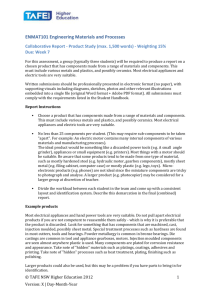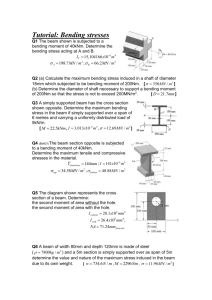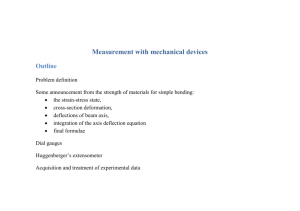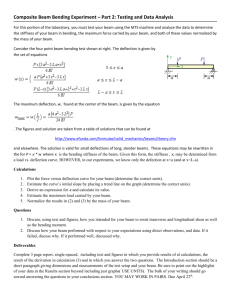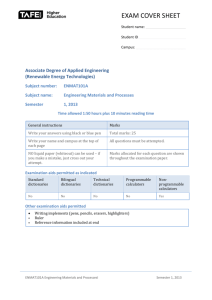ENMAT101A_Laboratory_5_Bending
advertisement
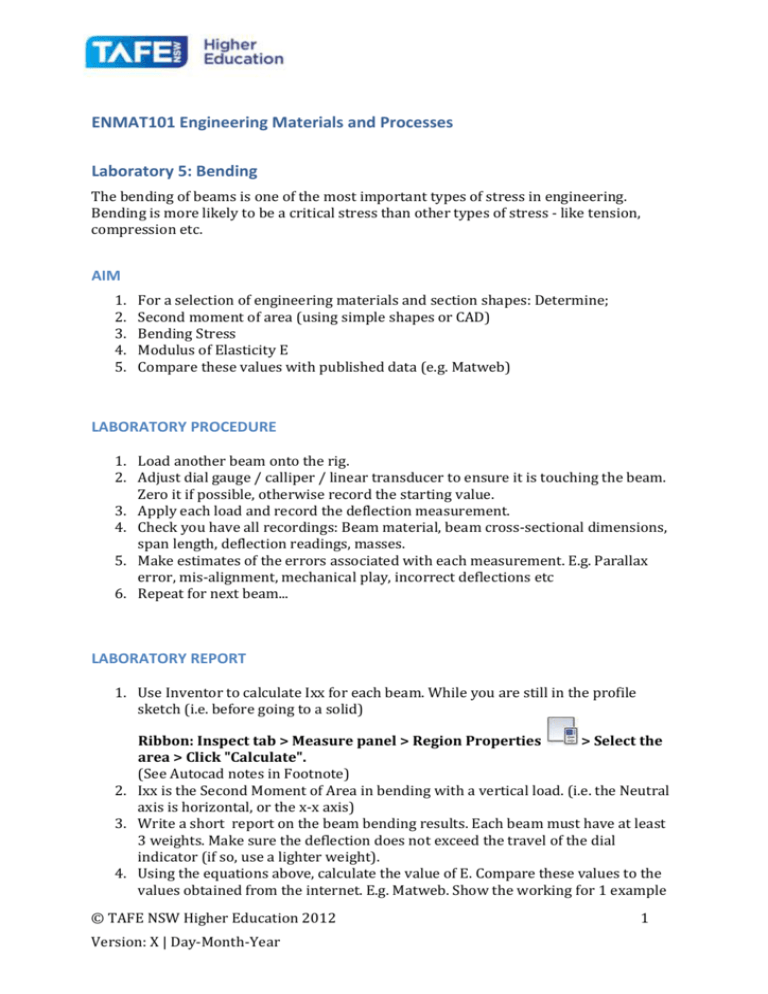
ENMAT101 Engineering Materials and Processes Laboratory 5: Bending The bending of beams is one of the most important types of stress in engineering. Bending is more likely to be a critical stress than other types of stress - like tension, compression etc. AIM 1. 2. 3. 4. 5. For a selection of engineering materials and section shapes: Determine; Second moment of area (using simple shapes or CAD) Bending Stress Modulus of Elasticity E Compare these values with published data (e.g. Matweb) LABORATORY PROCEDURE 1. Load another beam onto the rig. 2. Adjust dial gauge / calliper / linear transducer to ensure it is touching the beam. Zero it if possible, otherwise record the starting value. 3. Apply each load and record the deflection measurement. 4. Check you have all recordings: Beam material, beam cross-sectional dimensions, span length, deflection readings, masses. 5. Make estimates of the errors associated with each measurement. E.g. Parallax error, mis-alignment, mechanical play, incorrect deflections etc 6. Repeat for next beam... LABORATORY REPORT 1. Use Inventor to calculate Ixx for each beam. While you are still in the profile sketch (i.e. before going to a solid) Ribbon: Inspect tab > Measure panel > Region Properties > Select the area > Click "Calculate". (See Autocad notes in Footnote) 2. Ixx is the Second Moment of Area in bending with a vertical load. (i.e. the Neutral axis is horizontal, or the x-x axis) 3. Write a short report on the beam bending results. Each beam must have at least 3 weights. Make sure the deflection does not exceed the travel of the dial indicator (if so, use a lighter weight). 4. Using the equations above, calculate the value of E. Compare these values to the values obtained from the internet. E.g. Matweb. Show the working for 1 example © TAFE NSW Higher Education 2012 Version: X | Day-Month-Year 1 calculation, but only give the rest of the answers in a table. Use Excel to do your calculations. 5. Determine the maximum stress for each mass (load) added to the beams. 6. Discuss any sources of error in the experiment - esp measurements - and how they might affect the results. Specify an overall error for your calculation of E. © TAFE NSW Higher Education 2012 Version: X | Day-Month-Year 2 NOTES: BENDING TEST Finding Bending Stress and Modulus of Elasticity E The bending of beams is one of the most important types of stress in engineering. Bending is more likely to be a critical stress than other types of stress - like tension, compression etc. In this laboratory, we will be determining the Modulus of Elasticity E (also called Young's Modulus) of the various materials and using Solid Edge to determine the Second Moment of Area for the different cross-sections. Bending Equations Use units: Force (N), Length (mm), Stress (MPa) E = Young's Modulus or Mod of Elasticity (MPa) I = 2nd Moment of Area or Area Moment (mm4). Can calculate using SolidEdge sketch. © TAFE NSW Higher Education 2012 Version: X | Day-Month-Year 3 In our case, we must first convert the mass to Newtons (N). W = kg * 9.81 L is the span length in (mm). I is the Second Moment of Area in (mm4). We can calculate this for a rectangle using a simple formula; For other shapes it is not so simple. We need to calculate these using a CAD program (see footnote). Determining the value of E in MPa. © TAFE NSW Higher Education 2012 Version: X | Day-Month-Year 4 From the above equation, Deflection z = W * L3 / (48 * E * I) so E = W * L3 / (48 * z * I) Determining Stress in MPa. From the above equation, Bending Moment (Nmm) M = W*L / 4 and Maximum Stress (MPa) f = M * y / I where y = distance from centroid to the bottom (or top) of the beam. This is simply half the depth for all the symmetrical beams except the channel. To find the centroid for the channel you need to use Solid Edge again (same as the Ixx window) © TAFE NSW Higher Education 2012 Version: X | Day-Month-Year 5 Errors (If required by teacher) (Pre-requisite: Errors test Tester #11104_Errors. See notes on Error Analysis.) Record the absolute error for each measurement: The absolute error is the sum of several factors: Absolute error = (Resolution / 2) + (Parallax error) + (misalignment error) + (systmatic error) Where: Resolution Error = smallest increment in the measurement scale. The human limit is considered to be half of this again. For example, this dial gauge has smallest increment = 0.01mm, so it is considered to be readable to 0.005mm. Parallax error is an error caused by viewing the meaurement at an angle. Parallax is an apparent displacement or difference of orientation of an object viewed along two different lines of sight. This is why the passenger in a car thinks you are going over the speed limit, but from the driver's view, the needle says the car is going the right speed! Parallax is avoided by looking straight-on, and also kept to a minimum by keeping the needle close to the scale. Your estimate of parallax error depends on the geomtery of the measurement, but for the gauge above the parallax error would be only about 10% of the increment. Misalignment error: Not taking the measurement parallel or perpendicular. Eg.The dial gauge is not vertical, the tape measure is at an angle, the caliper is not perpendicular etc. This is not supposed to happen if you take the measurement carefully, but some meaurements are more difficult than others. © TAFE NSW Higher Education 2012 Version: X | Day-Month-Year 6 Systematic error: An error inherent in the measuring instrument itself. Eg a tape measure is inaccurate due to temperature change, or it is actually printed wrong! Hopefully this is not a problem, but the only way top check is to check the calibration against a known standard. Note: In 2012 the deflection was measured manually using a dial caliper. This avoids the spring force of the dial indicator changing the deflection of the lighter beams (e.g. wooden beam). It also has greater deflection than the 10mm of the dial indicator. Lab Notes Beam Bending Lab (Word Doc: 3 pages) Relevant pages in MDME Mechanical Properties practice test: 10101cp Web Links Links for information about scientific errors http://instructor.physics.lsa.umich.edu/ip-labs/tutorials/errors/vocab.html http://dwb.unl.edu/Teacher/NSF/C14/C14Links/www.chem.ualberta.ca/course s/plambeck/p101/p01017.htm http://mathforum.org/library/drmath/view/61050.html © TAFE NSW Higher Education 2012 Version: X | Day-Month-Year 7 Using INVENTOR to calculate Second Moment of Area (Ixx) Second_Moment_of_Area Using CAD (Inventor 2011) to determine Second Moment of Area (1MB) Using AUTOCAD to calculate Second Moment of Area (Ixx) From: http://forums.autodesk.com/t5/AutoCAD-2009/MOMENT-OF-INERTIA-secondmoment-of-area/td-p/2427626/page/2 When you need to find the second moment of area for complex profiles use massprop. (type into command line) Draw your profile close to the origin. Use polylines. If your profile has arcs, use the command pedit to convert arcs to pline. then convert to region (command line). If your profile is hollow, use subtract to subtract the hole regions from the outer region. then run massprop. If you didn't draw the object with centroid on the origin, then you need to shift centroid onto the origin... Locate centroid from massprop Move profile to (X,Y)= (0,0) Now run massprop again and you will get Ixx and Iyy OK. Nice info. Now let's see if we can get this to actually work... 1. Polylines: If you didn't draw the shape in one continuous polyline, well, you should of. Failing that, we'll have to convert them. Converting: Video showing the PEDIT command as mentioned above; http://www.youtube.com/watch?v=4SXh4eJWHbo When a shape is closed (which it should be here), a quicker way is BPOLY. (Boundary Creation in Polylines) http://www.youtube.com/watch?v=o4qSbvCdcHc 2. Region: Yep. Just type Region and click the loop. Bingo - it's now a region. 3. Massprop: Seems to work fine too. I think you should be right from here... Should look something like below. Here's an example (Autocad screen dump) from an Area Moment question in 10305 Area Moments, unit MEM30006A. © TAFE NSW Higher Education 2012 Version: X | Day-Month-Year 8 © TAFE NSW Higher Education 2012 Version: X | Day-Month-Year 9
